An Over-Actuated Hexacopter Tilt-Rotor UAV Prototype for Agriculture of Precision: Modeling and Control
Abstract
1. Introduction
1.1. State of the Art and Related Works
1.2. Contributions
- Modeling and control of a new over-actuated HTR prototype, equipped with eight independently operating actuators, designed specifically for PA applications;
- Description of the two propulsion motors, which can be independently adjusted using servomotors, enabling enhanced maneuverability, forward and backward movements without the need to change the pitch angle, and more efficient yaw control;
- Simulations using software-in-the-loop in the Gazebo software environment using real agricultural scenarios, allowing the evaluation of performance in complex PA missions and validating the aircraft in close to real-world conditions before experimental tests with the HTR’s physical implementation;
- Implementation of an extended FCA technique within the PX4 board, which divides the CEM into two subsystems, allowing fast and decoupled control allocation;
- Implementation of the control structure with a cascaded P- PID topology directly into the PX4 firmware, making the HTR able to operate in physical environments and perform missions in real PA scenarios;
- Development of a routine that enables the connection of servomotors and propulsion motors (devices with different pulse width modulation (PWM) frequencies), directly influencing the FCA convergence procedure.
1.3. Paper Organization
2. HTR Kinematics and Dynamics Modeling
3. Control Structure
- Sufficient controllability to sustain level flight and transition from one equilibrium condition to another;
- The control forces must be within the permissible limits provided in the design;
- The airplane must be capable of stabilization throughout the flight envelope.
Servomotors and Propulsion Motors Interaction
4. Extended FCA Technique
5. Simulation Setup and Experimental Results
5.1. Simulation Setup
5.2. Experimental Results
5.2.1. Scenario A
5.2.2. Scenario B
6. Conclusions
Future Works
Author Contributions
Funding
Data Availability Statement
Acknowledgments
Conflicts of Interest
References
- Leme, F.P. Sistema Embarcado para Controle de Plataforma de dois Eixos Utilizada em Veiculos Aereos nao Tripulados. Ph.D. Thesis, UNICAMP, Campinas, Brazil, 2017. [Google Scholar]
- Rezende, H.B.; Silva, M.F.; Santos, M.F.; Honório, L.M.; Silva, L.A.Z.; Vidal, V.F.; Ribeiro, J.M.S.; Cerqueira, A.S.; Pancoti, A.A.N.; Regina, B.A. Signal estimation for UAV control loop identification using artificial immune systems. In Proceedings of the 22nd International Conference on System Theory, Control and Computing (ICSTCC), Sinaia, Romania, 10–12 October 2018; IEEE: Piscataway, NJ, USA, 2018; pp. 579–584. [Google Scholar]
- Garg, P.K. Unmanned Aerial Vehicles: An Introduction; Mercury Learning and Information: Herndon, VA, USA, 2021. [Google Scholar]
- Cavallaro, S.L.H. Modelagem, Simulação e Controle de VANT do Tipo Quadricóptero. Ph.D. Thesis, Universidade de São Paulo, São Paulo, Brazil, 2019. [Google Scholar]
- Evers, R.; Masters, P. The application of low-altitude near-infrared aerial photography for detecting clandestine burials using a UAV and low-cost unmodified digital camera. Forensic Sci. Int. 2018, 289, 408–418. [Google Scholar] [CrossRef] [PubMed]
- Berger, G.S.; Júnior, A.O.; Braun, J.; Lima, J.; Pinto, M.F.; Valente, A.; Pereira, A.I.; Cantieri, Á.R.; Wehrmeister, M.A. Sensorial Testbed for High-Voltage Tower Inspection with UAVs. In Proceedings of the ROBOT2022: Fifth Iberian Robotics Conference; Tardioli, D., Matellán, V., Heredia, G., Silva, M.F., Marques, L., Eds.; Springer: Cham, Switzerland, 2023; pp. 353–364. [Google Scholar]
- Leal Lopes, V.M.; Honório, L.M.; Santos, M.F.; Pancoti, A.A.; Silva, M.F.; Diniz, L.F.; Mercorelli, P. Design of an Over-Actuated Hexacopter Tilt-Rotor for Landing and Coupling in Power Transmission Lines. Drones 2023, 7, 341. [Google Scholar] [CrossRef]
- Bolla, G.M.; Casagrande, M.; Comazzetto, A.; Dal Moro, R.; Destro, M.; Fantin, E.; Colombatti, G.; Aboudan, A.; Lorenzini, E.C. ARIA: Air Pollutants Monitoring Using UAVs. In Proceedings of the 2018 5th IEEE International Workshop on Metrology for AeroSpace (MetroAeroSpace), Rome, Italy, 20–22 June 2018; pp. 225–229. [Google Scholar] [CrossRef]
- Nihei, K.; Kai, N.; Maruyama, Y.; Yamashita, T.; Kanetomo, D.; Kitahara, T.; Maruyama, M.; Ohki, T.; Kusin, K.; Segah, H. Forest Fire Surveillance using Live Video Streaming from UAV via Multiple LTE Networks. In Proceedings of the 2022 IEEE 19th Annual Consumer Communications & Networking Conference (CCNC), Las Vegas, NV, USA, 8–11 January 2022; pp. 465–468. [Google Scholar] [CrossRef]
- Dong, J.; Ota, K.; Dong, M. UAV-based real-time survivor detection system in post-disaster search and rescue operations. IEEE J. Miniaturization Air Space Syst. 2021, 2, 209–219. [Google Scholar] [CrossRef]
- Noguchi, T.; Komiya, Y. Persistent Cooperative Monitoring System of Disaster Areas Using UAV Networks. In Proceedings of the 2019 IEEE SmartWorld, Ubiquitous Intelligence & Computing, Advanced & Trusted Computing, Scalable Computing & Communications, Cloud & Big Data Computing, Internet of People and Smart City Innovation (SmartWorld/SCALCOM/UIC/ATC/CBDCom/IOP/SCI), Leicester, UK, 19–23 August 2019; pp. 1595–1600. [Google Scholar] [CrossRef]
- Hiebert, B.; Nouvet, E.; Jeyabalan, V.; Donelle, L. The application of drones in healthcare and health-related services in north america: A scoping review. Drones 2020, 4, 30. [Google Scholar] [CrossRef]
- Outay, F.; Mengash, H.A.; Adnan, M. Applications of unmanned aerial vehicle (UAV) in road safety, traffic and highway infrastructure management: Recent advances and challenges. Transp. Res. Part A Policy Pract. 2020, 141, 116–129. [Google Scholar] [CrossRef]
- Yang, Z.; Yu, X.; Dedman, S.; Rosso, M.; Zhu, J.; Yang, J.; Xia, Y.; Tian, Y.; Zhang, G.; Wang, J. UAV remote sensing applications in marine monitoring: Knowledge visualization and review. Sci. Total Environ. 2022, 838, 155939. [Google Scholar] [CrossRef]
- Popescu, D.; Stoican, F.; Stamatescu, G.; Ichim, L.; Dragana, C. Advanced UAV–WSN system for intelligent monitoring in precision agriculture. Sensors 2020, 20, 817. [Google Scholar] [CrossRef]
- Monteiro, A.; Santos, S.; Gonçalves, P. Precision Agriculture for Crop and Livestock Farming—Brief Review. Animals 2021, 11, 2345. [Google Scholar] [CrossRef] [PubMed]
- Aslan, M.F.; Durdu, A.; Sabanci, K.; Ropelewska, E.; Gültekin, S.S. A Comprehensive Survey of the Recent Studies with UAV for Precision Agriculture in Open Fields and Greenhouses. Appl. Sci. 2022, 12, 1047. [Google Scholar] [CrossRef]
- Messina, G.; Modica, G. Applications of UAV Thermal Imagery in Precision Agriculture: State of the Art and Future Research Outlook. Remote Sens. 2020, 12, 1491. [Google Scholar] [CrossRef]
- Silva, M.F.; Ribeiro, A.C.; Santos, M.F.; Carmo, M.J.; Honório, L.M.; Oliveira, E.J.; Vidal, V.F. Design of angular PID controllers for quadcopters built with low cost equipment. In Proceedings of the 20th International Conference on System Theory, Control and Computing (ICSTCC), Sinaia, Romania, 13–15 October 2016; pp. 216–221. [Google Scholar] [CrossRef]
- Vidal, V.F.; Honório, L.M.; Santos, M.F.; Silva, M.F.; Cerqueira, A.S.; Oliveira, E.J. UAV vision aided positioning system for location and landing. In Proceedings of the 18th International Carpathian Control Conference (ICCC), Sinaia, Romania, 28–31 May 2017; IEEE: Piscataway, NJ, USA, 2017; pp. 228–233. [Google Scholar]
- Silva, M.F.; Cerqueira, A.S.; Vidal, V.F.; Honório, L.M.; Santos, M.F.; Oliveira, E.J. Landing area recognition by image applied to an autonomous control landing of VTOL aircraft. In Proceedings of the 18th International Carpathian Control Conference (ICCC), Sinaia, Romania, 28–31 May 2017; IEEE: Piscataway, NJ, USA, 2017; pp. 240–245. [Google Scholar]
- Hegde, N.T.; George, V.I.; Nayak, C.G. Modelling and Transition flight control of Vertical Take-Off and Landing unmanned Tri-Tilting Rotor Aerial Vehicle. In Proceedings of the 3rd International Conference on Electronics, Communication and Aerospace Technology (ICECA), Coimbatore, India, 12–14 June 2019; pp. 590–594. [Google Scholar] [CrossRef]
- Delavarpour, N.; Koparan, C.; Nowatzki, J.; Bajwa, S.; Sun, X. A technical study on UAV characteristics for precision agriculture applications and associated practical challenges. Remote Sens. 2021, 13, 1204. [Google Scholar] [CrossRef]
- Kouadio, L.; El Jarroudi, M.; Belabess, Z.; Laasli, S.E.; Roni, M.Z.K.; Amine, I.D.I.; Mokhtari, N.; Mokrini, F.; Junk, J.; Lahlali, R. A Review on UAV-Based Applications for Plant Disease Detection and Monitoring. Remote Sens. 2023, 15, 4273. [Google Scholar] [CrossRef]
- Meng, J.; Cheng, Z. Improving the estimation of soil-available nutrients at the sub-field scale using time-series UAV observations. Remote. Sens. Lett. 2020, 11, 739–747. [Google Scholar] [CrossRef]
- Apolo-Apolo, O.; Martínez-Guanter, J.; Egea, G.; Raja, P.; Pérez-Ruiz, M. Deep learning techniques for estimation of the yield and size of citrus fruits using a UAV. Eur. J. Agron. 2020, 115, 126030. [Google Scholar] [CrossRef]
- Feng, A.; Zhou, J.; Vories, E.D.; Sudduth, K.A.; Zhang, M. Yield estimation in cotton using UAV-based multi-sensor imagery. Biosyst. Eng. 2020, 193, 101–114. [Google Scholar] [CrossRef]
- Shi, X.; Du, Y.; Liu, X.; Liu, C.; Hou, Q.; Chen, L.; Yong, R.; Ma, J.; Yang, D.; Yuan, H.; et al. Optimizing UAV spray parameters to improve precise control of tobacco pests at different growth stages. Pest Manag. Sci. 2024, 80, 5809–5819. [Google Scholar] [CrossRef]
- Guo, A.; Huang, W.; Dong, Y.; Ye, H.; Ma, H.; Liu, B.; Wu, W.; Ren, Y.; Ruan, C.; Geng, Y. Wheat Yellow Rust Detection Using UAV-Based Hyperspectral Technology. Remote Sens. 2021, 13, 123. [Google Scholar] [CrossRef]
- López-Granados, F.; Torres-Sánchez, J.; Jiménez-Brenes, F.M.; Oneka, O.; Marín, D.; Loidi, M.; de Castro, A.I.; Santesteban, L.G. Monitoring Vineyard Canopy Management Operations Using UAV-Acquired Photogrammetric Point Clouds. Remote Sens. 2020, 12, 2331. [Google Scholar] [CrossRef]
- Ferro, M.V.; Sørensen, C.G.; Catania, P. Comparison of different computer vision methods for vineyard canopy detection using UAV multispectral images. Comput. Electron. Agric. 2024, 225, 109277. [Google Scholar] [CrossRef]
- Pádua, L.; Matese, A.; Di Gennaro, S.F.; Morais, R.; Peres, E.; Sousa, J.J. Vineyard classification using OBIA on UAV-based RGB and multispectral data: A case study in different wine regions. Comput. Electron. Agric. 2022, 196, 106905. [Google Scholar] [CrossRef]
- Bagadiaa, R. Exploratory Design and Control of an Over-Actuated Drone. Master’s Thesis, EECS Department, University of California, Berkeley, CA, USA, 2023. [Google Scholar]
- Santos, M.F.; Honório, L.M.; Costa, E.B.; Oliveira, E.J.; Visconti, J.P.P.G. Active fault-tolerant control applied to a hexacopter under propulsion system failures. In Proceedings of the 19th International Conference on System Theory, Control and Computing (ICSTCC), Cheile Gradistei, Romania, 14–16 October 2015; IEEE: Piscataway, NJ, USA, 2015; pp. 447–453. [Google Scholar]
- Rojo-Rodriguez, E.U.; Rojo-Rodriguez, E.G.; Araujo-Estrada, S.A.; Garcia-Salazar, O. Design and performance of a novel tapered wing tiltrotor UAV for hover and cruise missions. Machines 2024, 12, 653. [Google Scholar] [CrossRef]
- Santos, M.; Honório, L.; Moreira, A.P.G.M.; Garcia, P.A.N.; Silva, M.; Vidal, V.F. Analysis of a fast control allocation approach for nonlinear over-actuated systems. ISA Trans. 2022, 126, 545–561. [Google Scholar] [CrossRef]
- Pimentel, G.O.; Dos Santos, M.F.; de Mello Honório, L.; Mercorelli, P.; Da Silva, M.F.; Moreira, A.P.G.M. Design, modeling and control of an over-actuated hexacopter tilt-rotor. In Proceedings of the 24th International Carpathian Control Conference (ICCC), Miskolc-Szilvasvarad, Hungary, 12–14 June 2023; IEEE: Piscataway, NJ, USA, 2023; pp. 315–320. [Google Scholar]
- Beard, R.; McLain, T. Small Unmanned Aircraft: Theory and Practice; Princeton University Press: Princeton, NJ, USA, 2012. [Google Scholar]
- Ducard, G.J. Fault-Tolerant Flight Control and Guidance Systems: Practical Methods for Small Unmanned Aerial Vehicles; Springer Science & Business Media: Berlin/Heidelberg, Germany, 2009. [Google Scholar]
- Santos, M.F.; Honório, L.M.; Costa, E.B.; Silva, M.F.; Vidal, V.F.; Neto, A.F.S.; Rezende, H.B.; Mercorelli, P.; Pancoti, A. Detection time analysis of propulsion system fault effects in a hexacopter. In Proceedings of the 20th International Carpathian Control Conference (ICCC), Krakow-Wieliczka, Poland, 26–29 May 2019; IEEE: Piscataway, NJ, USA, 2019; pp. 1–6. [Google Scholar]
- Santos, M.F. Alocação de Controle Desacoplada rápida em Sistemas de Controle Superatuados. Ph.D Thesis, Universidade Federal de Juiz de Fora (UFJF), Juiz de Fora, Brazil, 2019. [Google Scholar]
- Bonzatto Junior, L.; Berger, G.S.; Braun, J.; Pinto, M.F.; dos Santos, M.F.; Júnior, A.O.; Nowakowski, M.; Costa, P.; Wehrmeister, M.A.; Lima, J. A Comparison of PID Controller Architectures Applied in Autonomous UAV Follow up of UGV. In Iberian Robotics Conference; Springer: Cham, Switzerland, 2023; pp. 26–37. [Google Scholar]
- Santos, M.F.; Silva, M.F.; Vidal, V.F.; Honório, L.M.; Lopes, V.L.M.; Silva, L.A.Z.; Rezende, H.B.; Ribeiro, J.M.S.; Cerqueira, A.S.; Pancoti, A.A.N. Experimental validation of quadrotors angular stability in a gyroscopic test bench. In Proceedings of the 22nd International Conference on System Theory, Control and Computing (ICSTCC), Sinaia, Romania, 10–12 October 2018; IEEE: Piscataway, NJ, USA, 2018; pp. 783–788. [Google Scholar]
- da Silva, M.F.; Honório, L.M.; Marcato, A.L.M.; Vidal, V.F.; Santos, M.F. Unmanned aerial vehicle for transmission line inspection using an extended Kalman filter with colored electromagnetic interference. ISA Trans. 2020, 100, 322–333. [Google Scholar] [CrossRef]
- Ge, Z.; Liu, F.; Meng, L. Adaptive PID Control for Second Order Nonlinear Systems. In Proceedings of the 2020 Chinese Control And Decision Conference (CCDC), Hefei, China, 22–24 August 2020; pp. 2926–2931. [Google Scholar] [CrossRef]
- Basri, M.A.M. Trajectory Tracking of a Quadcopter UAV using PID Controller. Elektr.-J. Electr. Eng. 2023, 22, 14–21. [Google Scholar]
- Rajan, M.N.; Velmurugan, G. Design and Testing of a Hexacopter Sprayer for Controlled Deforestation and Pest Control. In Proceedings of the 2023 4th International Conference on Smart Electronics and Communication (ICOSEC), Trichy, India, 20–22 September 2023; pp. 50–56. [Google Scholar] [CrossRef]
- Chiew, T.H.; Lee, H.E.; Lee, Y.K.; Chang, K.M.; Ong, J.J.; Eu, K.S. Second order sliding mode controller for altitude and yaw control of quadcopter. In Proceedings of the 11th IEEE International Conference on Control System, Computing and Engineering (ICCSCE), Penang, Malaysia, 27–28 August 2021; IEEE: Piscataway, NJ, USA, 2021; pp. 97–102. [Google Scholar]
- Al-Mahasneh, A.J.; Anavatti, S.G.; Ferdaus, M.; Garratt, M.A. Adaptive neural altitude control and attitude stabilization of a hexacopter with uncertain dynamics. In Proceedings of the IEEE International Conference on Industry 4.0, Artificial Intelligence, and Communications Technology (IAICT), Bali, Indonesia, 1–3 July 2019; IEEE: Piscataway, NJ, USA, 2019; pp. 44–49. [Google Scholar]
- dos Santos, M.F.; de Mello Honório, L.; da Silva, M.F.; Silva, W.R.; de Magalhães Lima, J.L.S.; Mercorelli, P.; do Carmo, M.J. Cascade MIMO P-PID Controllers Applied in an Over-actuated Quadrotor Tilt-Rotor. In Proceedings of the 24th International Carpathian Control Conference (ICCC), Miskolc-Szilvasvarad, Hungary, 12–14 June 2023; IEEE: Piscataway, NJ, USA, 2023; pp. 135–140. [Google Scholar]
- Santos, M.F.; Honório, L.M.; Moreira, A.P.G.M.; Silva, M.F.; Vidal, V.F. Fast Real-Time Control Allocation Applied to Over-Actuated Quadrotor Tilt-Rotor. J. Intell. Robot. Syst. 2021, 102, 65. [Google Scholar] [CrossRef]
- dos Santos, M.F.; de Mello Honório, L.; da Silva, M.F.; Vidal, V.F.; Mercorelli, P. Nonlinear control allocation applied on a QTR: The influence of the frequency variation. In Modeling, Identification, and Control for Cyber-Physical Systems Towards Industry 4.0; Elsevier: Amsterdam, The Netherlands, 2024; pp. 311–325. [Google Scholar]
- Santos, M.F.; Pereira, V.S.; Ribeiro, A.C.; Silva, M.F.; do Carmo, M.J.; Vidal, V.F.; Honório, L.M.; Cerqueira, A.S.; Oliveira, E.J. Simulation and comparison between a linear and nonlinear technique applied to altitude control in quadcopters. In Proceedings of the 18th International Carpathian Control Conference (ICCC), Sinaia, Romania, 28–31 May 2017; IEEE: Piscataway, NJ, USA, 2017; pp. 234–239. [Google Scholar]
- Durham, W.C. Constrained control allocation. J. Guid. Control. Dyn. 1993, 16, 717–725. [Google Scholar] [CrossRef]
- Ahani, A.; Ketabdari, M.J. Alternative approach for dynamic-positioning thrust allocation using linear pseudo-inverse model. Appl. Ocean. Res. 2019, 90, 101854. [Google Scholar] [CrossRef]
- Bodson, M.; Frost, S.A. Load balancing in control allocation. J. Guid. Control. Dyn. 2011, 34, 380–387. [Google Scholar] [CrossRef]
- Simon, D.; Härkegård, O.; Löfberg, J. Command governor approach to maneuver limiting in fighter aircraft. J. Guid. Control. Dyn. 2017, 40, 1514–1527. [Google Scholar] [CrossRef]
- Silva, D.H.C.; Santos, M.F.; Silva, M.F.; Neto, A.F.S.; Mercorelli, P. Design of controllers applied to autonomous unmanned aerial vehicles using software in the loop. In Proceedings of the 20th International Carpathian Control Conference (ICCC), Krakow-Wieliczka, Poland, 26–29 May 2019; IEEE: Piscataway, NJ, USA, 2019; pp. 1–6. [Google Scholar]
- Farley, A.; Wang, J.; Marshall, J.A. How to pick a mobile robot simulator: A quantitative comparison of CoppeliaSim, Gazebo, MORSE and Webots with a focus on accuracy of motion. Simul. Model. Pract. Theory 2022, 120, 102629. [Google Scholar] [CrossRef]
- Santos, M.F.; Silva, D.H.C.; Silva, M.F.; Vidal, V.; Honório, L.M.; Lopes, V.L.M.; Silva, L.A.Z.; Rezende, H.B.; Ribeiro, J.M.S.; Cerqueira, A.; et al. Project and design of multi-rate loop controllers for fixed-wings aircrafts. In Proceedings of the 22nd International Conference on System Theory, Control and Computing (ICSTCC), Sinaia, Romania, 10–12 October 2018; IEEE: Piscataway, NJ, USA, 2018; pp. 777–782. [Google Scholar]
- Ficco, M.; Palmiero, R.; Rak, M.; Granata, D. MAVLink Protocol for Unmanned Aerial Vehicle: Vulnerabilities Analysis. In Proceedings of the 2022 IEEE Intl Conf on Dependable, Autonomic and Secure Computing, Intl Conf on Pervasive Intelligence and Computing, Intl Conf on Cloud and Big Data Computing, Intl Conf on Cyber Science and Technology Congress (DASC/PiCom/CBDCom/CyberSciTech), Falerna, Italy, 12–15 September 2022; pp. 1–6. [Google Scholar] [CrossRef]
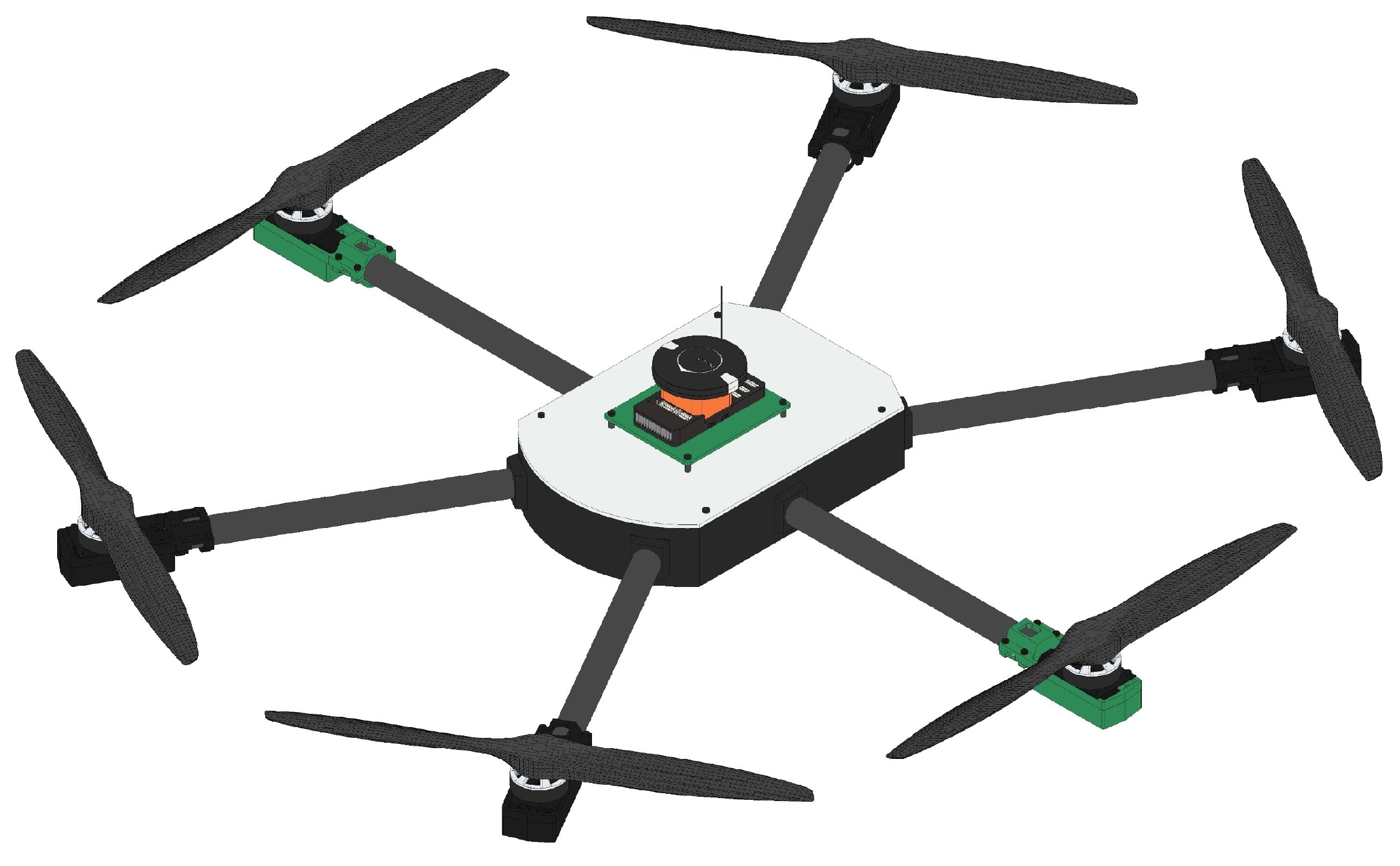



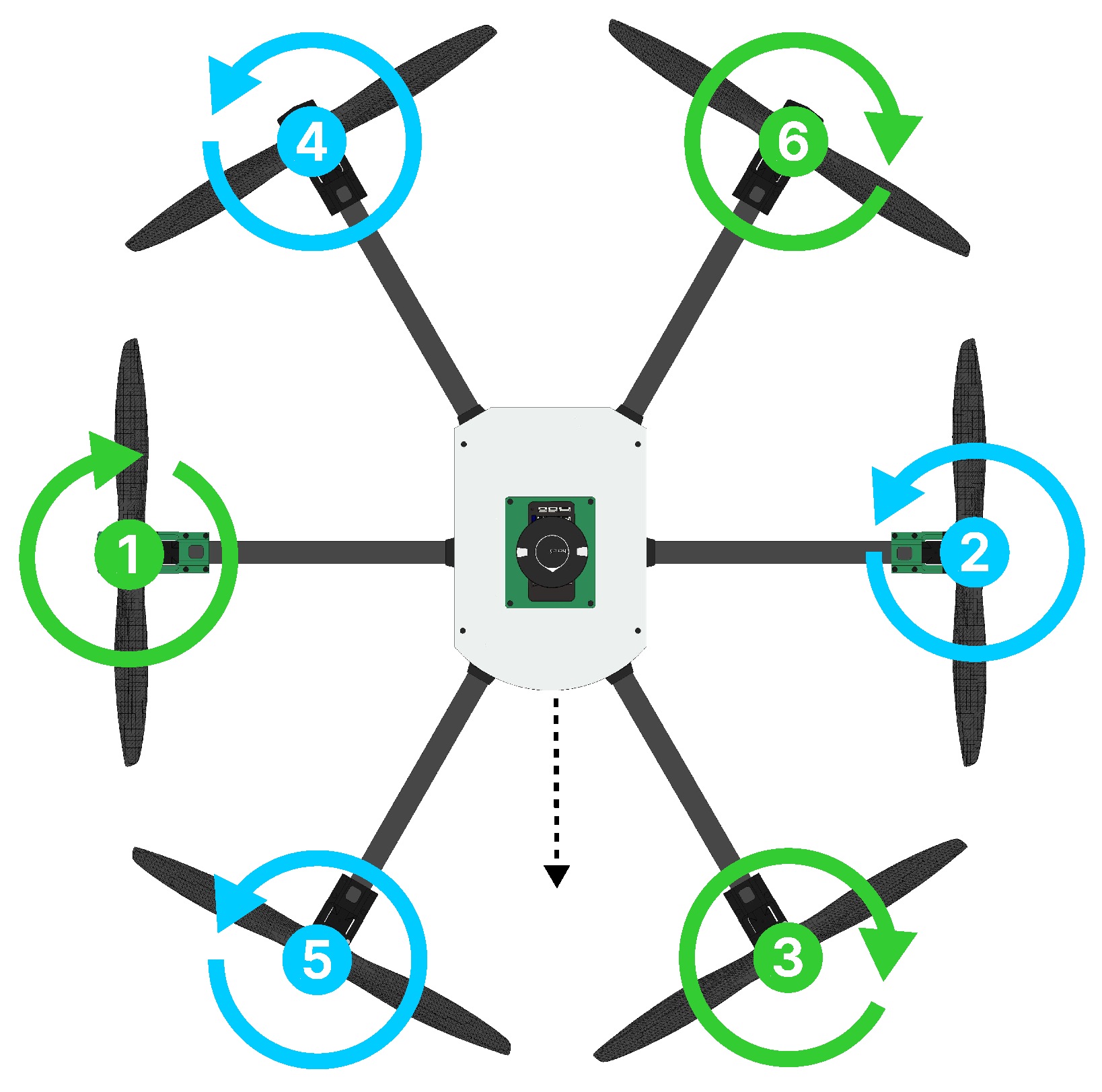
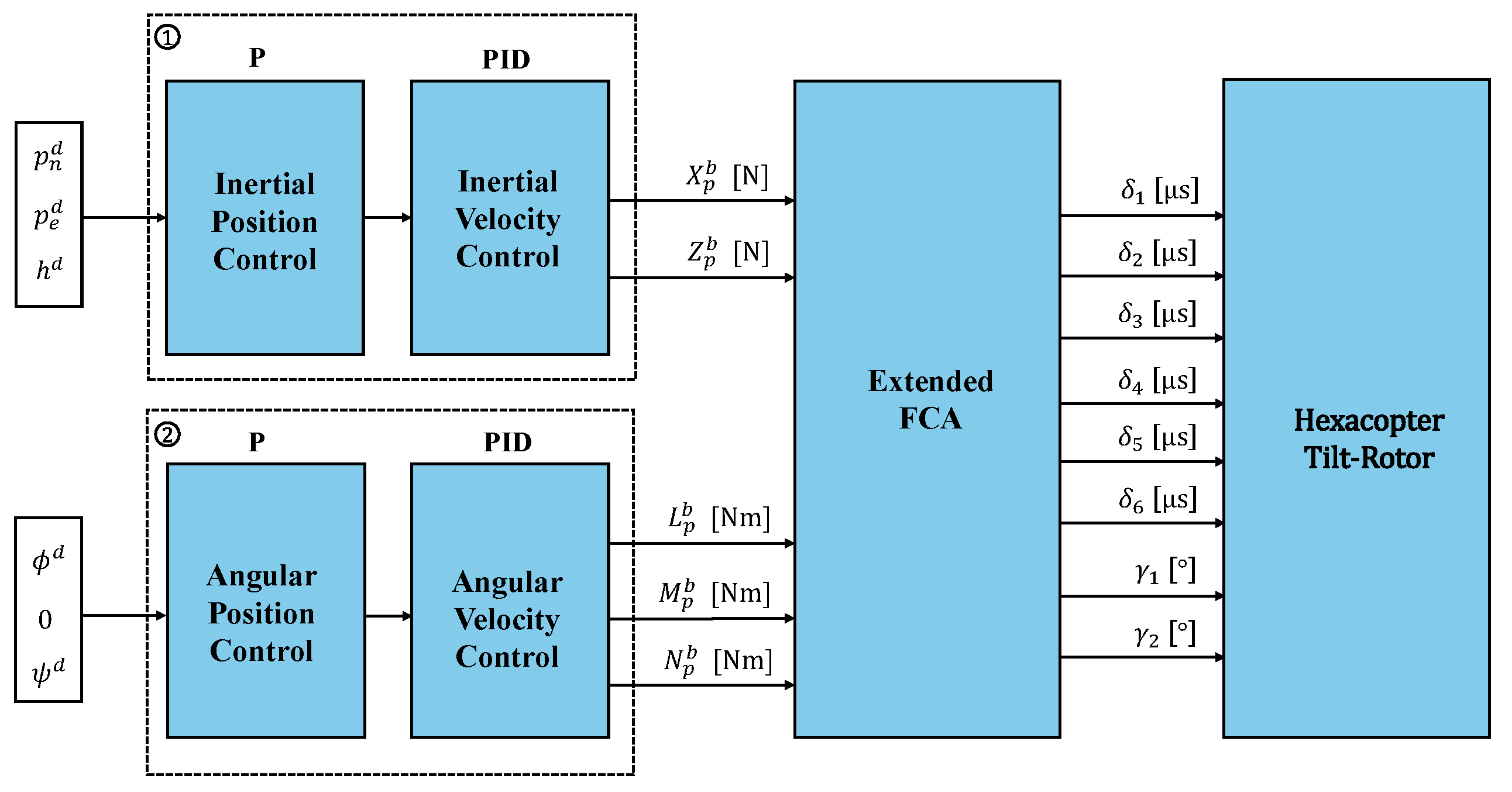
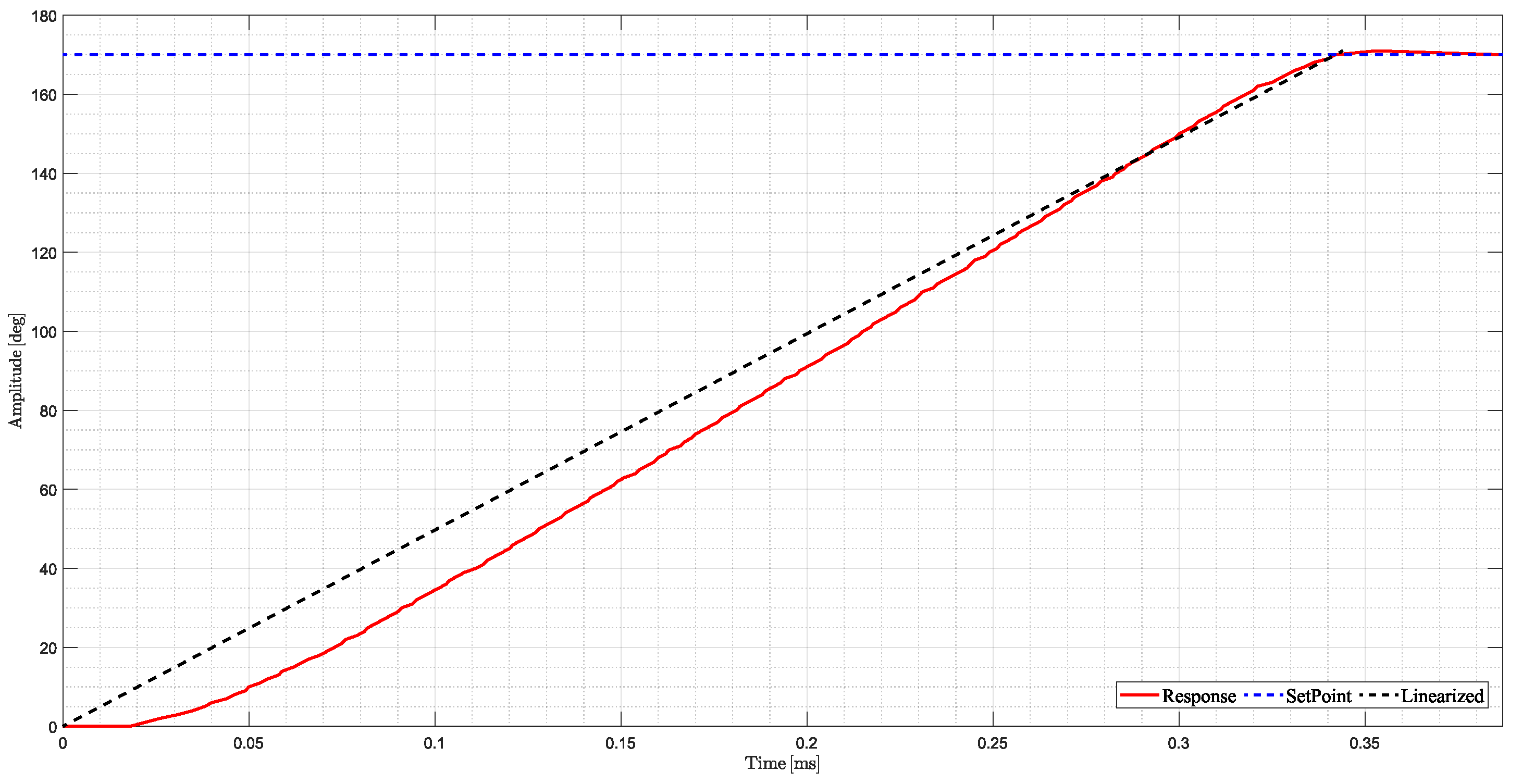


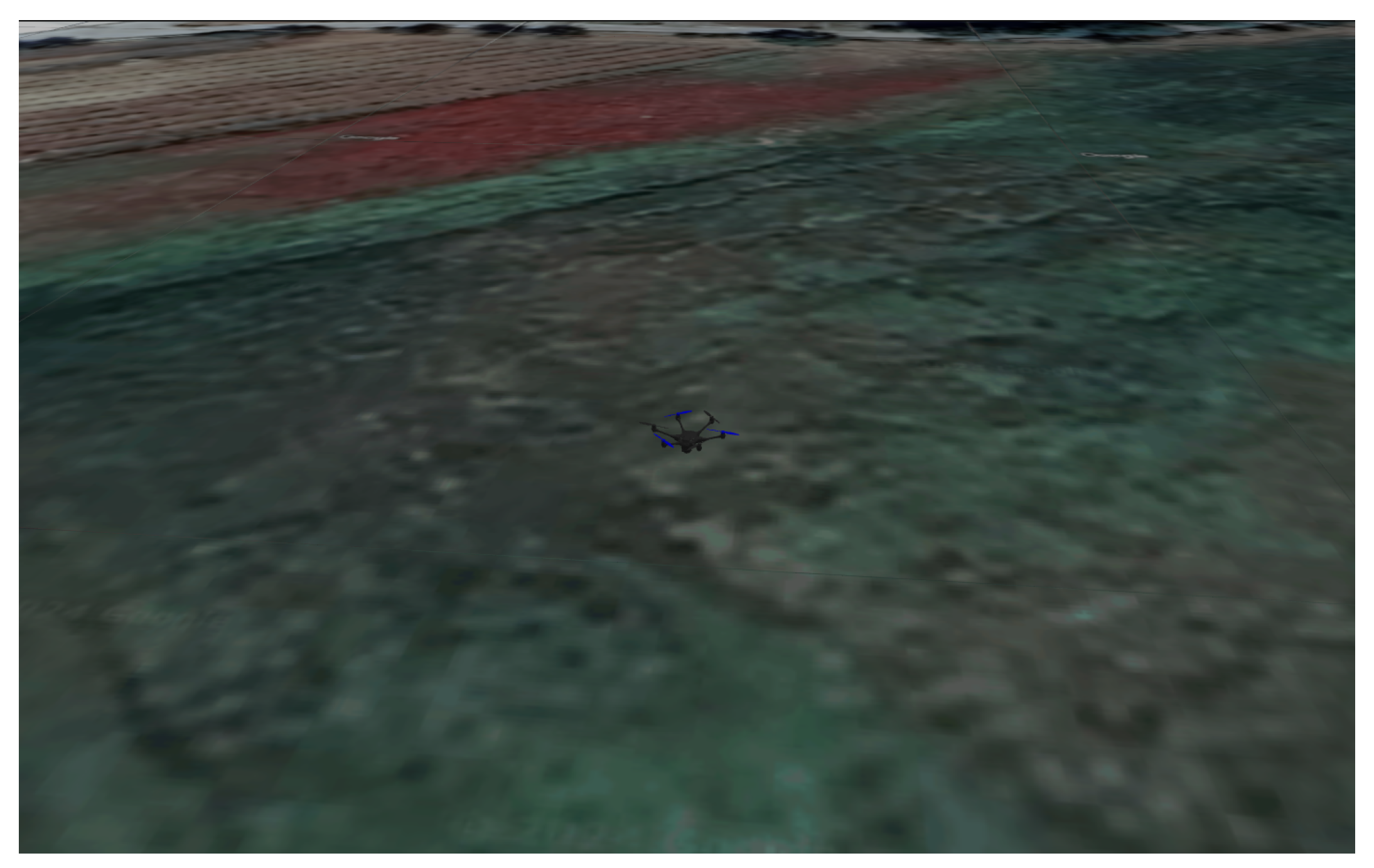



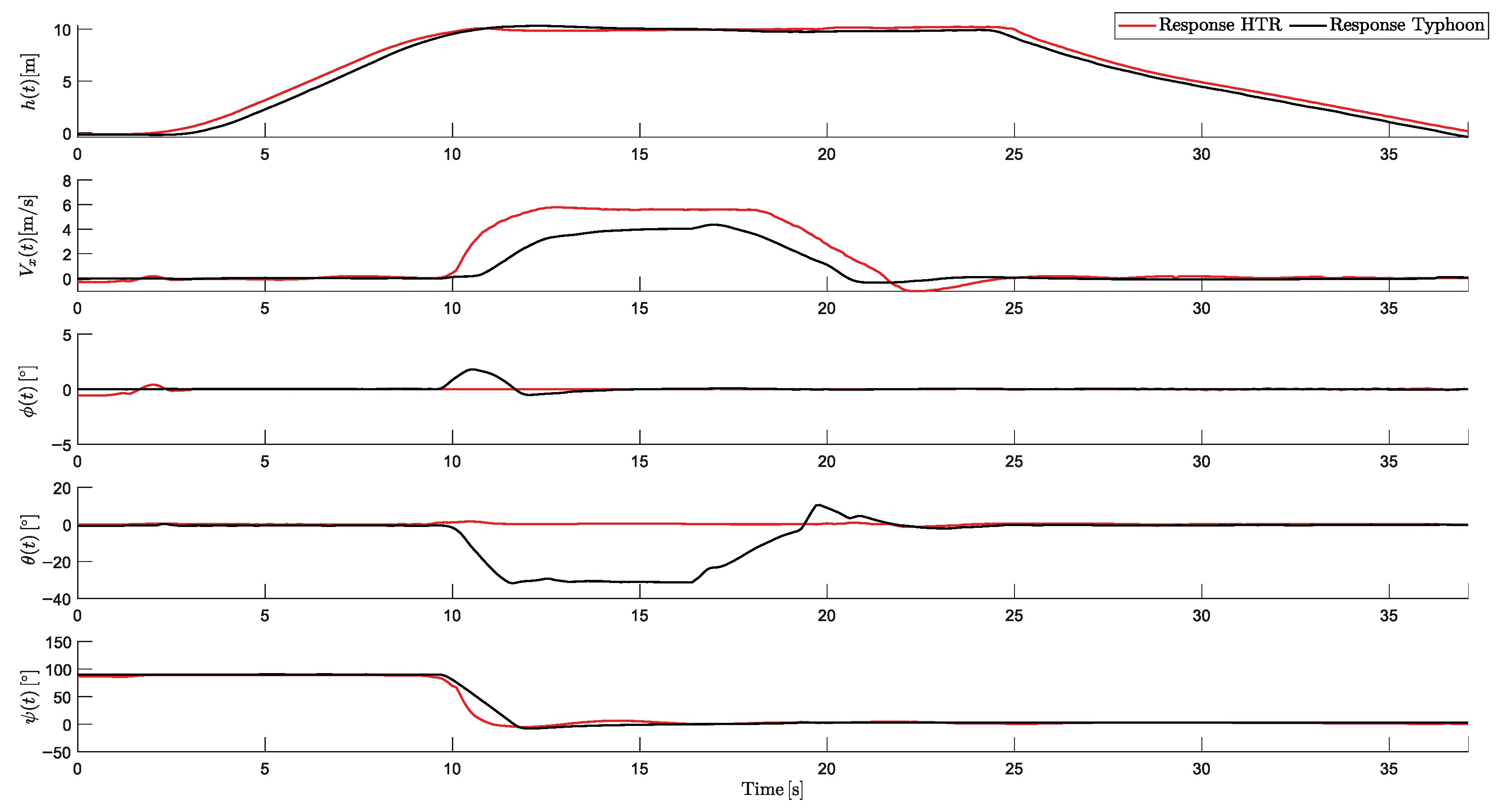

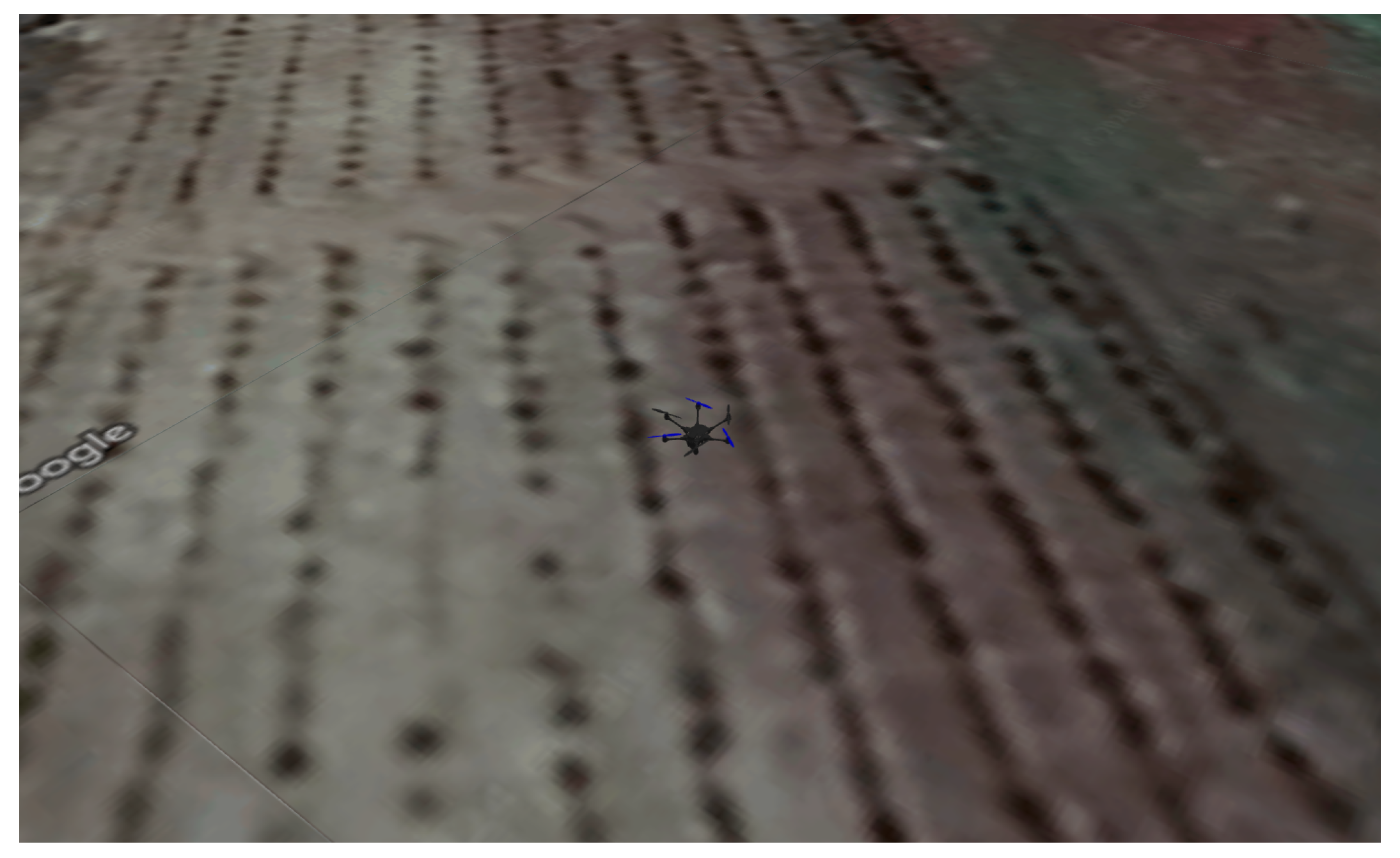
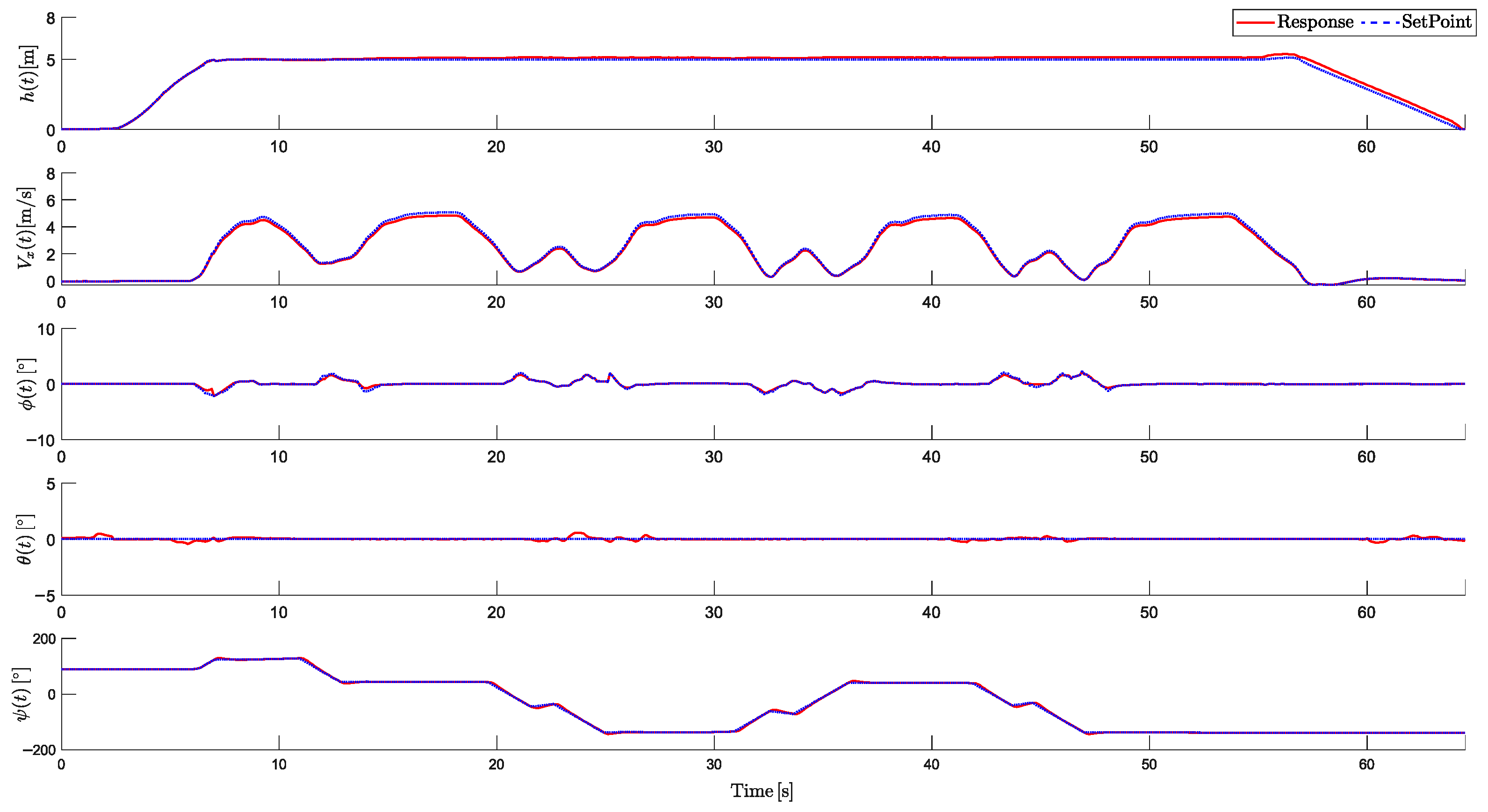



| Variable | P | ||
|---|---|---|---|
| h | |||
| P | I | D | |
| u | |||
| v | |||
| w | |||
| p | |||
| q | |||
| r | |||
| Variable | h | ||
|---|---|---|---|
| Variable | h | ||
|---|---|---|---|
Disclaimer/Publisher’s Note: The statements, opinions and data contained in all publications are solely those of the individual author(s) and contributor(s) and not of MDPI and/or the editor(s). MDPI and/or the editor(s) disclaim responsibility for any injury to people or property resulting from any ideas, methods, instructions or products referred to in the content. |
© 2025 by the authors. Licensee MDPI, Basel, Switzerland. This article is an open access article distributed under the terms and conditions of the Creative Commons Attribution (CC BY) license (https://creativecommons.org/licenses/by/4.0/).
Share and Cite
Pimentel, G.O.; Santos, M.F.d.; Lima, J.; Mercorelli, P.; Fernandes, F.M. An Over-Actuated Hexacopter Tilt-Rotor UAV Prototype for Agriculture of Precision: Modeling and Control. Sensors 2025, 25, 479. https://doi.org/10.3390/s25020479
Pimentel GO, Santos MFd, Lima J, Mercorelli P, Fernandes FM. An Over-Actuated Hexacopter Tilt-Rotor UAV Prototype for Agriculture of Precision: Modeling and Control. Sensors. 2025; 25(2):479. https://doi.org/10.3390/s25020479
Chicago/Turabian StylePimentel, Gabriel Oliveira, Murillo Ferreira dos Santos, José Lima, Paolo Mercorelli, and Fernanda Mara Fernandes. 2025. "An Over-Actuated Hexacopter Tilt-Rotor UAV Prototype for Agriculture of Precision: Modeling and Control" Sensors 25, no. 2: 479. https://doi.org/10.3390/s25020479
APA StylePimentel, G. O., Santos, M. F. d., Lima, J., Mercorelli, P., & Fernandes, F. M. (2025). An Over-Actuated Hexacopter Tilt-Rotor UAV Prototype for Agriculture of Precision: Modeling and Control. Sensors, 25(2), 479. https://doi.org/10.3390/s25020479










